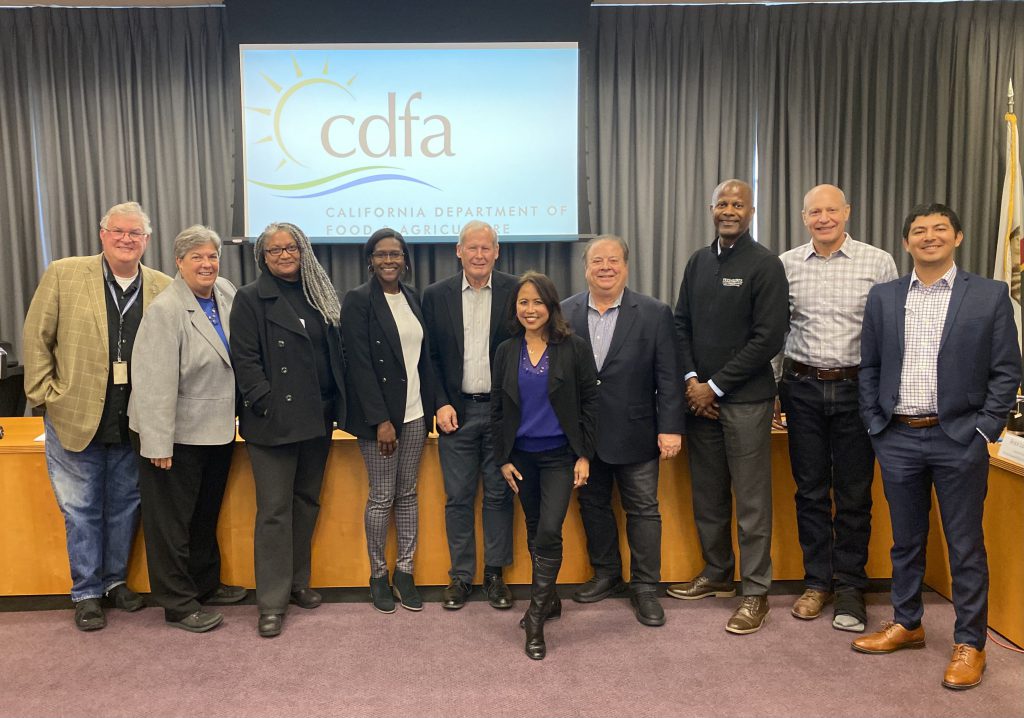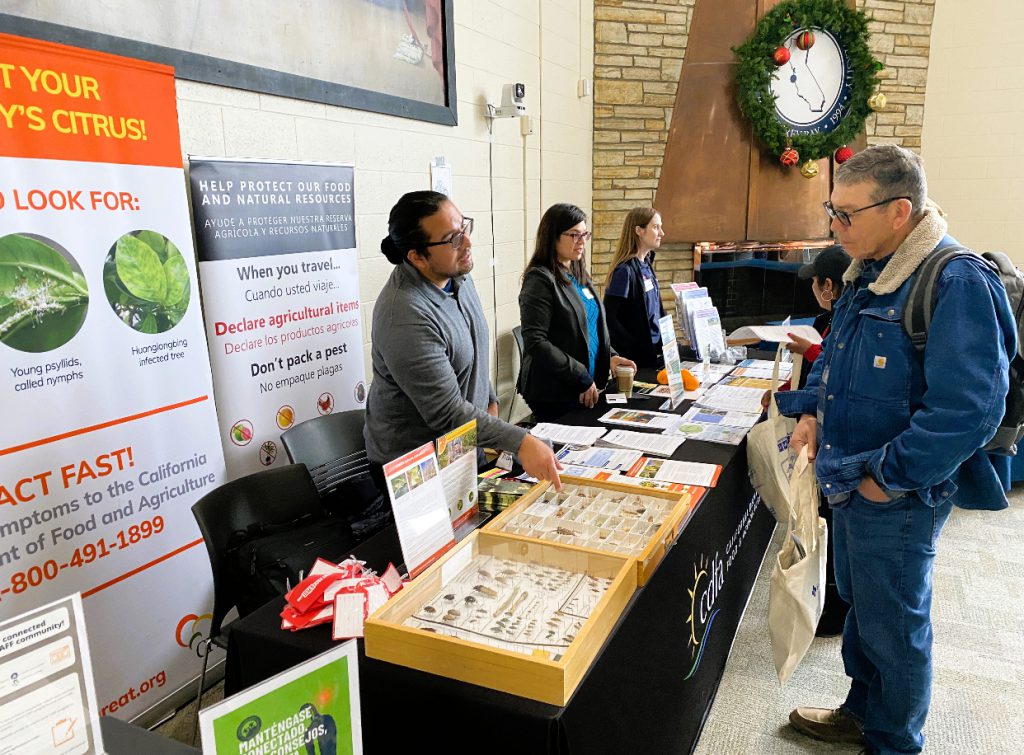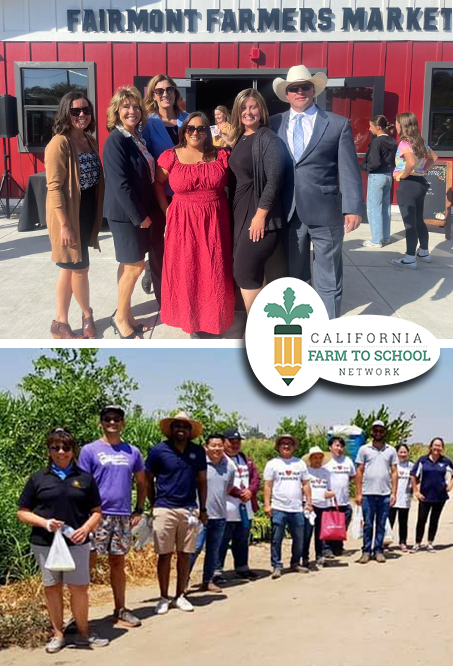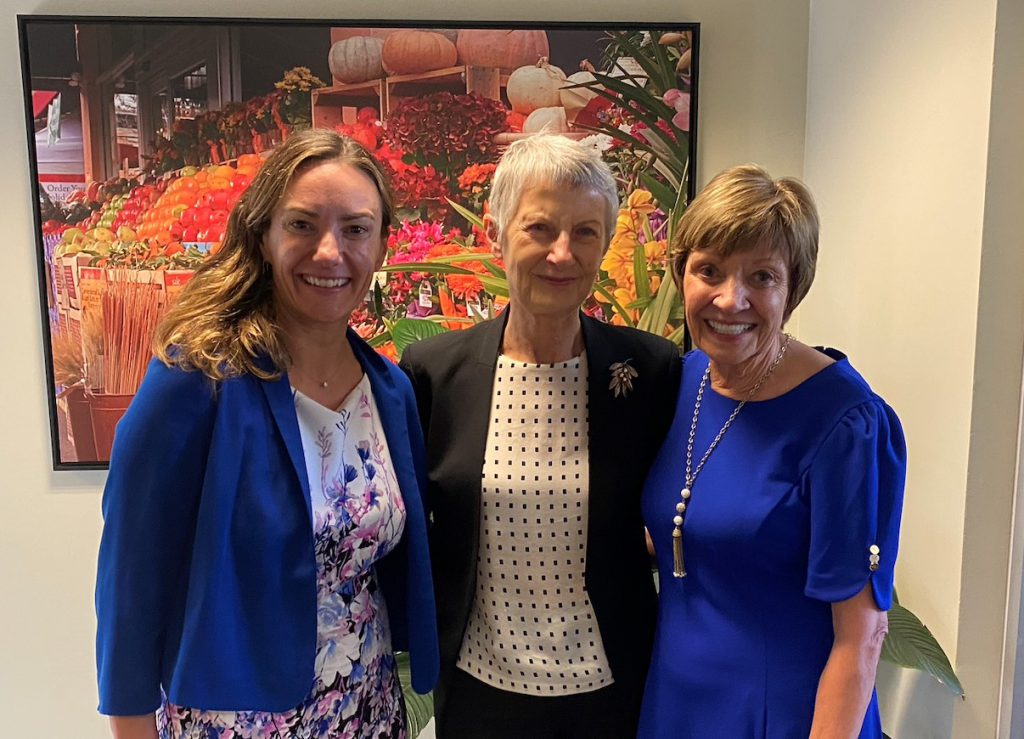



Representatives from across CDFA divisions and programs participated in the 10th annual Latino Farmer Conference, held this week at California State University, Monterey Bay. The two-day event, hosted by the National Center for Appropriate Technology and the U.S. Department of Agriculture, brought together Spanish-speaking farmers and ranchers to discuss sustainable agriculture, equity, and resources for underserved communities.
This year’s conference featured farm site tours in the Monterey Bay Area, with stops at four farms showcasing diverse production systems and on-farm conservation practices. Farmers shared their experiences with cover crops, wildlife habitat, and other climate-smart approaches that enhance sustainability and resilience. These tours provided attendees with practical insights into innovative agricultural methods.
CDFA hosted two booths during the conference, featuring staff and information from the Farm Equity Office, the Plant Health and Pest Prevention Services Division, the Office of Environmental Farming and Innovation (OEFI), and the Animal Health and Food Safety Services Division, the Fertilizer Research and Education Program, and Farmer & Farmworker Mental Health Resources.
Workshops conducted in Spanish focused on access to land, beneficial agreements and contracts, cooperative marketing strategies, conservation practices and cover crops for healthy soils, berry production, irrigation management, and also included a session about poultry production and profitability, in which Dr. Ricardo Gaitán, with CDFA’s Animal Health and Food Safety Services Division, gave a presentation about Highly Pathogenic Avian Influenza (HPAI), which is impacting dairy and poultry farms in the Central Valley.
The Latino Farmer Conference facilitates networking opportunities with other farmers and ranchers, produce buyers, industry and equipment specialists, and technical service providers. The conference underscores CDFA’s ongoing commitment to supporting all farmers and ranchers through collaboration and education.
CDFA and the Monterey County Farm Bureau are announcing the joint release of the report “California Agricultural Neighbors: Building a Proactive Food Safety Culture.”
California Agricultural Neighbors (CAN) was formed in January 2021 to bring together members of the Salinas Valley agriculture community to review what could be done to help reduce outbreaks of pathogenic Escherichia coli (E. coli) O157:H7 associated with leafy greens.
CAN initially facilitated discussions to enhance food safety practices between neighboring farms when various agricultural operations are adjacent to one another. An Action Report released in 2022 touched on neighbor-to-neighbor best practices.
Four work groups then focused on those practices to develop the new report, which offers next steps to continue to build a proactive food safety culture:
Click here to view “California Agricultural Neighbors: Building a Proactive Food Safety Culture.”
Click here to view a flyer about the report and its Next Steps.
In recognition of the cultural tradition of Day of the Dead (Día de los Muertos), November 1 and 2, Pixca Farm is proud of celebrating through its sustainable agricultural practices.
Erik Rodriguez’s journey into farming began in Rosarito, where he grew up at his family’s bookstore on the main boulevard. His mother, however, wanted him to experience life away from town, and so he would spend his days at his godfather’s ranch, helping harvest cilantro, radishes, and calabazas (pumpkins). Working on the land sparked a love for farming in Erik that would one day lead him to co-manage Pixca Farm in the Tijuana River Valley of San Diego County.
Years later, Erik was furloughed from his job at the YMCA during the COVID-19 pandemic. Gardening had always been a passion, and while volunteering at Pixca Farm, he found himself at a crossroads—try to return to his job or take a leap into full-time farming. Erik chose farming and reconnected with Leonard Vargas, a founding member of Pixca with more than 30 years of agricultural experience. Together, they focused on Pixca Farm, which has since become a source of fresh, pesticide-free vegetables, flowers, and herbs for the San Diego community.
Growing Marigolds and a Community Connection
One of the farm’s key crops is marigolds, or cempasúchil, known for their vibrant orange color and cultural significance, especially during the Day of the Dead celebration. Erik and his team prepare around 500 bunches of marigolds, handpicked and bound into bunches of nine to ten stems. While the flowers are in high demand, especially around this time, Pixca Farm grows the marigolds without pesticides, which Erik shares with his customers.
Pixca Farm contributes to California’s dominance in marigold production. According to the most recent data from the USDA National Agricultural Statistics Service, in 2019, California led the nation in marigold production with $10.5 million in wholesale and retail sales.
“The marigolds serve more than just a decorative purpose; they play a significant role in natural pest management on the farm,” said Erik. By rotating flowers, including marigolds and sunflowers, through each plot, Erik minimizes pest issues and maximizes soil health. “We try to win with numbers and know that pests are going to happen. We do a rotation with marigolds through every section of the farm within one to two years, including sunflowers,” explained Erik. Pixca Farm has marigolds growing all season long and he throws them into mixed bouquets.
Operating on just half an acre, Pixca Farm produces a diverse range of vegetables like carrots, beets, radishes, cilantro, zucchini, and even tomatoes in bumper crop quantities. They sell these at a farm stand, which has become popular.
Pixca Farm’s mission, symbolized by its name—a take on the Spanish word for “pick”—is not only to provide healthy food but also to foster a deeper connection with the land. Erik’s call to action for consumers is: “Support local agriculture, support small businesses.” He emphasizes that with San Diego having the largest number of farms in California, it’s essential to support smaller, family-operated farms in California.

October is National Farm to School Month. CDFA encourages educators, school food service employees, farmers and farm to school enthusiasts across California to join in the celebration. Visit https://www.farmtoschool.org/ for more information.
Did you know CDFA’s Farm to School Program has regional staff throughout California available to foster farm to school participation and connect producers with local school districts?
Farm to School Network Regional Leads are working to facilitate relationships with partners across the school food ecosystem and more. For example, Farm to School Network San Joaquin Regional Lead Jane Alvarado Banister recently worked with Sanger Unified School District to connect their educational initiatives with the school meal program. In the accompanying photo, Jane joins Sanger Unified officials at the ribbon cutting for the Fairmont Ag Complex, an agricultural education hub for the region.
Farm to School Regional Producer Engagement Specialists are working to provide value chain coordination for producers looking to sell foods to school districts with a focus on small and midsize farms and ranches. For example, Farm to School Central Regional Producer Engagement Specialist Michael Ackley-Grady recently helped the Asian Business Institute and Resource Center (ABIRC) connect Fresno Unified School District (FUSD) with local, ethnically diverse farmers so that the school may incorporate new crops into school meals that are culturally appropriate for many of the students. In the accompanying photo, Michael joins FUSD officials and others on an ABIRC-led tour and taste-test of ethnically diverse micro farms.
There are eight California Farm to School Regions. Reach out to contact the regional staff in your area!
Superior Region
Jennifer Rogge, Farm to School Network Regional Lead, Jennifer.Rogge@cdfa.ca.gov
Mike Whamond, Farm to School Regional Producer Engagement Specialist, Michael.Whamond@cdfa.ca.gov
North Coast Region
Pamela Lee, Farm to School Network Regional Lead, Pamela.Lee
Meerae Park, Farm to School Regional Producer Engagement Specialist, Meerae.Park@cdfa.ca.gov
Bay Area Region
Lizzy Elliott, Farm to School Network Regional Lead, Lizzy.Elliott@cdfa.ca.gov
Central Region
Michael Ackley-Grady, Farm to School Regional Producer Engagement Specialist, Michael.Ackley-Grady@cdfa.ca.gov
San Joaquin Region
Jane Alvarado-Banister, Farm to School Network Regional Lead, Jane.Banister@cdfa.ca.gov
South Coast Region
Jacqueline Day, Farm to School Network Regional Lead, Jacqueline.Day@cdfa.ca.gov
Chris Massa, Farm to School Regional Producer Engagement Specialist, Chris.Massa@cdfa.ca.gov
Greater Los Angeles Region
Sophia Riemer Bopp, Farm to School Network Regional Lead, Sophia.Bopp@cdfa.ca.gov
Tracey Kimura, Farm to School Regional Producer Engagement Specialist, Tracey.Kimura@cdfa.ca.gov
Southern Region
Molly Jones, Farm to School Network Regional Lead, Molly.Jones@cdfa.ca.gov
Jennifer Huang, Farm to School Regional Producer Engagement Specialist, Jennifer.Huang@cdfa.ca.gov
State and federal government agencies signed a historic Memorandum of Understanding (MOU) yesterday at California Natural Resources Agency headquarters, advancing long-term watershed health through floodplain restoration in the Sacramento River Basin.
The agreement brings together partners from agriculture, water, flood control, and wildlife management to implement large-scale, multi-benefit projects that protect communities, restore habitats, and support sustainable farming.
Among the key agencies involved are CDFA, the California Natural Resources Agency, California Department of Fish and Wildlife, the California Department of Water Resources, the U.S. Fish and Wildlife Service, the U.S. Bureau of Reclamation, the U.S. Bureau of Land Management, the U.S. Army Corps of Engineers, and the National Fish and Wildlife Foundation.
The Sacramento River Basin spans more than 1,100 square miles from Sacramento to Chico and is a vast and hardworking system with floodplains providing essential habitat for fish and wildlife while acting as natural flood protection for cities and farms.
CDFA Secretary Karen Ross signed the MOU on behalf of the agency and said, “Farming is place-based. Rice farmers and others in Northern California have been fearless partners, showing how floodplains can benefit both fish, birds, and agriculture. Together, we’re building drought resilience, enabling groundwater recharge, and creating healthier ecosystems.”
Key Outcomes of the MOU:
This multi-agency partnership exemplifies how conservation and farming can work together to address climate challenges, sustain ecosystems, and ensure food security. With investments in floodplain restoration and a sharing of responsibility across agencies and sectors, this MOU sets a precedent for sustainable water and habitat management in California.

Note: The FIRA USA event taking place in Woodland from October 22-24, is free and open to all growers.
The third annual FIRA USA event in Woodland, California, held at the Yolo County Fairgrounds (October 22 to 24), is a showcase for agricultural robotics and automation. Focused on innovation in the agriculture industry, the event draws key stakeholders from across the state to discuss how technology is shaping the future of food production and driving economic growth.
In addition to various panels and demonstrations, the California State Board of Food and Agriculture convened at FIRA yesterday to discuss agricultural innovation and technology.
A highlight was a panel discussion called Building an Agricultural Technology Innovation Economy, featuring CDFA secretary Karen Ross, along with Derek Kirk, Senior Advisor for Economic Policy at the Governor’s Office of Business and Economic Development (GoBiz), and Hannah Johnson from The Vine at UC Agriculture and Natural Resources (UC ANR).
Food-producing regions across California are increasingly focused on technology as a driver of innovation. Both the state and federal governments have made substantial investments in tech-driven economic development. As Secretary Ross noted during the discussion, despite challenges such as climate change and water scarcity, California’s strategic advantages in crop diversity and productivity position it well for future growth while utilizing technological advancements.
Secretary Ross emphasized, “We still have many strategic advantages with the crops that we grow. There’s every reason to believe that we will continue to grow the gross revenues from our farms.” She highlighted how California’s innovative approach will also support a thriving bioeconomy.
Empowering Future Generations in Agriculture
The panel discussion also touched on the importance of attracting the next generation of farmers and innovators. Derek Kirk shared his experiences visiting the STAR (Strathmore Technical Agricultural Research) Center in the Porterville area, where young students are being introduced to ag tech. Kirk underscored the significance of this program in sustaining the industry’s workforce. “It’s exciting to see young students interested in the ag industry, and it shows real promise,” he said.
Secretary Ross stressed the need to focus on youth engagement in agriculture, which reflects the need to develop talent across the agri-food value chain. “That’s creating livable ways for families that want to stay in farming and all the other parts of the value chain,” she said.
Securing a Sustainable Future for Agriculture
As climate change reshapes the landscape of farming, Secretary Ross addressed healthy eating and nutrition as a path forward, emphasizing the importance of programs such as Farm-to-School initiatives connecting farmers to local economies while promoting healthy eating. “The real opportunity is in improving and enhancing our understanding of healthy eating from the youngest age possible to avoid chronic diseases which sucks so much out our economies now,” she said. “Filling nutrition gaps is going to be critically important in a changing climate.”
Looking ahead, Secretary Ross shared her vision for California agriculture, where a focus on problem-solving and collaboration ensures continued growth and innovation. “It’s exciting and very possible,” she said, envisioning a future where California remains a global leader in ag technology and innovation, all while ensuring that every Californian has access to healthy, nutritious food.

October is National Farm to School Month. CDFA encourages educators, school food service
employees, farmers and farm to school enthusiasts across California to join in
the celebration. Visit https://www.farmtoschool.org/ for more information.
The Palm Springs Unified School District (PSUSD) received CDFA Farm to School Incubator Grant Program funding appropriations in 2021 and 2022. Their project goals have included strengthening contractual relationships with local farmers by bringing them to campuses to cultivate and refurbish school gardens, hosting farmers’ markets, and expanding nutrition education through digital menu boards.
Throughout the 2023-2024 school year, PSUSD hosted farmers’ markets with locally grown produce at 26 of its 27 school sites. At the markets, students learned about the importance of eating fresh fruits and vegetables and met local farmers growing produce that students eat in their cafeterias.
California farmers who have participated in PSUSD’s programming include Mark Tadros from Aziz Farms in Thermal, Anna and Bob Knight from Old Grove Orange in Redlands, and Loren Werth from Food 4 Thought LLC in Fresno.
CDFA’s Farm to School Incubator Grant Program is part of California’s nation-leading investment in farm to school programs to cultivate equity, nurture students, build climate resilience, and create scalable and sustainable change. The grant program has awarded nearly $87 million in funding to 163 different entities serving 1.5 million public school students.

CDFA Secretary Karen Ross met with New Zealand Ambassador Rosemary Banks and Consul-General Katja Ackerley during a recent visit to Sacramento. CDFA and New Zealand’s Ministry of Primary Industry signed on Memorandum of Understanding (MOU) on Sustainable Agricultural Cooperation in October 2022. The State of California also welcomed the New Zealand Prime Minister earlier this year fostering a partnership on climate action.
California agricultural exports to New Zealand are estimated at more than $156 million.
As Hispanic Heritage Month (Sept 15-Oct 15) draws to a close, CDFA would like to profile Brisa Ranch of Pescadero (San Mateo County) and its co-owner, Veronica Mazariegos-Anastassiou. Growing up with roots in Guatemala and Venezuela, Veronica’s journey into agriculture began during her time as a Peace Corps volunteer in West Africa, where she developed a deep respect for subsistence farming.
Since 2018, Veronica and her business partners, Cole and Cristobal, have grown Brisa Ranch into a diversified fruit and vegetable operation. Located on California’s coast, the ranch benefits from a unique microclimate, allowing them to grow greens year-round and cultivate crops like tomatoes, peppers, and heirloom varieties of squash and corn. These crops not only reflect their cultural backgrounds but also meet the demands of local markets and communities. With Cristobal’s Oaxacan heritage and Cole’s Greek roots, Brisa Ranch has embraced diverse agricultural traditions.
The challenges Veronica and her partners face, like many small-scale farmers in California, are multifaceted. Land tenure and housing are significant obstacles, along with the unpredictable impacts of climate change, such as heavy rains and wildfires. Despite these hurdles, the ranch is committed to sustainable farming, employing cover cropping, crop rotation, and minimal tillage that prioritizes soil health and biodiversity. Flowers are grown to support pollinator habitats, further enhancing the ecological balance on their farm.
Veronica’s passion extends beyond the fields. As a member of the Small-Scale Producer Advisory Committee at CDFA, she helps represent the needs of small and minority-owned farms. She is also spearheading efforts to establish a food hub, which would connect local producers in San Mateo County with school districts and underserved communities.
“We have worked with four school districts that include Santa Cruz City Schools, Live Oak School District, San Lorenzo Valley Unified School District, and Alum Rock Union School District. We have also sold via regional food hubs that are working with school districts in other parts,” said Veronica. “We feel strongly about working with school districts to make sure local and organic produce is making it to school kitchens. As part of our work, students have visited our farm, and we have sent a member of our team to the schools to speak to the students.”
Veronica hopes that with the additional support being provided to schools and farms to strengthen the farm to school supply chain, she will be able to increase the number of school districts served and collaborate with other farms to distribute produce more efficiently. Through these efforts, Veronica is optimistic that more accessible and equitable food system can be created, ensuring that fresh, locally grown produce reaches those who need it most.
Veronica Mazariegos-Anastassiou and Brisa Ranch is a powerful example of how culture, sustainability, and community intersect in California’s agricultural landscape. The ranch is a testament to the resilience and innovation of Latina women farmers helping to shape the future of farming.